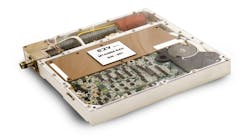Producing high levels of microwave power for transmit purposes has often invited debate over whether solid-state or vacuum-tube devices are better suited to the task. The MTA2000 series of microwave power modules (MPMs) puts such arguments to rest, however. Courtesy of e2v Aerospace and Defense (www.e2v-us.com), it combines both technologies in compact housings that can amplify high-frequency signals across multi-octave bandwidths. Some of the latest additions to this product line include the model MTA2001 (which delivers 100 W minimum output power from 6.0 to 18.0 GHz) and model MTA2002 (with 100 W minimum output power from 4.5 to 18.0 GHz).
The MTA2000 series of MPMs combines a mini-helix traveling-wave tube (TWT) with a solid-state preamplifier, an optimized high-density power supply, and control circuitry. The compact housing wastes little space in integrating these different components; it is rugged enough for commercial and military use in ground, shipborne, and airborne applications. In particular, the high ratio of microwave output power to package weight—or power density, as it is known—makes MPMs like these very attractive to developers of unmanned aerial vehicles (UAVs) for use in the microwave transmitter sections.
MPMs are available from a number of different suppliers—typically the same companies that develop their own TWTs. MPMs were originally developed for use in active phased-array antenna systems, as their power levels and small sizes made them suitable for mounting on the side of the antenna arrays. Seeing the potential in MPMs for shipborne applications, the technology has been driven strongly by the US Naval Research Laboratory (NRL), among other government agencies. Their intent is to extend the available power levels and frequency ranges, while also increasing the reliability of MPM-based systems.
MPMs leverage the best traits of solid-state and tube amplifiers. They benefit from the small size, low noise, and high gain of solid-state amplifiers at lower power levels and the high efficiency and output power of TWTs at relatively small sizes. The combination offers considerable improvement in power density compared to solid-state power amplifiers, at lower cost than possible with a solid-state amplifier, and with much lower noise figures than possible with a TWTA alone.
Depending upon the needs of an application, an MPM can be designed to provide either pulsed or continuous-wave (CW) output signals, typically at output-power levels from 50 to 150 W. The high-voltage power supply required by the TWT is usually tailored for high reliability over challenging environmental conditions, such as high altitudes, wide temperature ranges, and high vibration, while also made to fit into a limited package volume and to operate as efficiently as possible to limit power consumption. To coordinate the operation of its various components, microcontrollers are typically included in MPMs for control, sequencing, and performance monitoring.
The MPMs in the MTA2000 series are densely packed, supplied in a housing that is only 7.5 x 7.5 x 1 in. excluding the coaxial connectors. The firm offers broadband versions such as the MTA2001 and MTA2002 for multi-octave applications. Also included are narrowband versions, such as the models MTA2004 and MTA2005 with frequency ranges that can be customized for Ku-band satellite-communications (satcom) and X-band radar applications, respectively. The typical characteristics for a 6-to-18-GHz model MTA2001 MPM include 100 W (+50 dBm) minimum output power and 125 W (+51 dBm) typical output power over 0 to 100% duty cycle. The MPM is designed for RF input power of 0 ± 1 dBm, exhibiting an input VSWR of 2.0:1 and output VSWR of 2.50:1. The compact amplifier module operates from a +270-VDC supply, although other power options are available upon request.
In general, the MTA2000 series MPMs can be used at altitudes to 70,000 ft. They are designed for operating temperatures from -50 to +85°C and nonoperating (storage) temperatures from -55 to +100°C. The MPMs weigh 6.5 lbs. or less and include SMA female input connectors and TNC female output connectors. The package body is protected by an electroless nickel finish and conduction cooling is used to dissipate heat generated by the helix TWT. The built-in controller provides control and monitoring of the MPMs various operating conditions, including standby mode, high-voltage (HV) on, TWT beam on, over temperature, prime power, beam voltage and current, and helix current. In this package size and weight, the MPMs can support a wide range of commercial and military applications ranging from communications, electronic countermeasures (ECM), and radar systems, and the MPMs are even small enough for use on towed decoys. e2v aerospace and defense, inc. (incorporating QP Semiconductor), California e2v aerospace and defense, inc., 765 Sycamore Dr., Milpitas, CA 95035; (408) 737-0992, www.e2v.com/aero.
